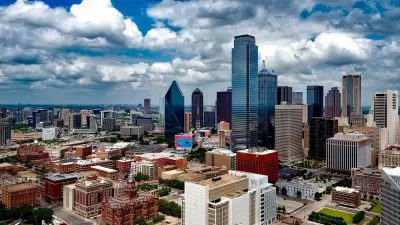As new studies show the fundamental connection between trees and human health, cities are recognizing the essential elements in cultivating thriving urban canopies. And they're enacting policies to ensure their protection and growth.
As Lindsay Abrams noted recently in The Atlantic, our ability to quantify the ways in which trees improve our physical and mental health - by providing oxygen, cleaning our air of pollutants, and in more nuanced ways - is steadily increasing. Despite this recognition, writes Leda Marritz, "The USDA Forest Service recently determined that U.S. cities are losing around 4 million trees annually — this at a time when average urban canopy cover in North America is still lower in most places than what is recommended by American Forests."
Why is it that cities continue to struggle to protect and grow their tree canopies? According to Marritz, creative director of DeepRoot Green Infrastructure and an ISA-certified arborist, at least part of the problem lies in the challenge of providing the right type and volume of soil to support tree growth. She points to examples from Toronto, Denver, Emeryville, and West Virginia, of ambitious policies that require street trees to receive a certain minimum amount of soil in order to support healthy urban forests.
"None of these policies is perfect," says Marritz. "There are tweaks, of varying sizes, that I would make to all of them. Still, they represent a critically important step to creating lasting, healthy, thriving urban canopy cover in cities."
"It takes more than a soil volume minimum to cultivate a thriving, mature urban canopy. Good tree stock, soil quality, adequate water and regular maintenance cannot be undervalued. But we’ll continue to lose canopy cover at an alarming rate if we don’t change the way we plant trees in cities," she concludes. "We know what this means, and we simply need to do it. It starts with soil."
FULL STORY: Saving the Urban Canopy

Planetizen Federal Action Tracker
A weekly monitor of how Trump’s orders and actions are impacting planners and planning in America.

San Francisco's School District Spent $105M To Build Affordable Housing for Teachers — And That's Just the Beginning
SFUSD joins a growing list of school districts using their land holdings to address housing affordability challenges faced by their own employees.

The Tiny, Adorable $7,000 Car Turning Japan Onto EVs
The single seat Mibot charges from a regular plug as quickly as an iPad, and is about half the price of an average EV.

Seattle's Plan for Adopting Driverless Cars
Equity, safety, accessibility and affordability are front of mind as the city prepares for robotaxis and other autonomous vehicles.

As Trump Phases Out FEMA, Is It Time to Flee the Floodplains?
With less federal funding available for disaster relief efforts, the need to relocate at-risk communities is more urgent than ever.

With Protected Lanes, 460% More People Commute by Bike
For those needing more ammo, more data proving what we already knew is here.
Urban Design for Planners 1: Software Tools
This six-course series explores essential urban design concepts using open source software and equips planners with the tools they need to participate fully in the urban design process.
Planning for Universal Design
Learn the tools for implementing Universal Design in planning regulations.
Smith Gee Studio
City of Charlotte
City of Camden Redevelopment Agency
City of Astoria
Transportation Research & Education Center (TREC) at Portland State University
US High Speed Rail Association
City of Camden Redevelopment Agency
Municipality of Princeton (NJ)




























